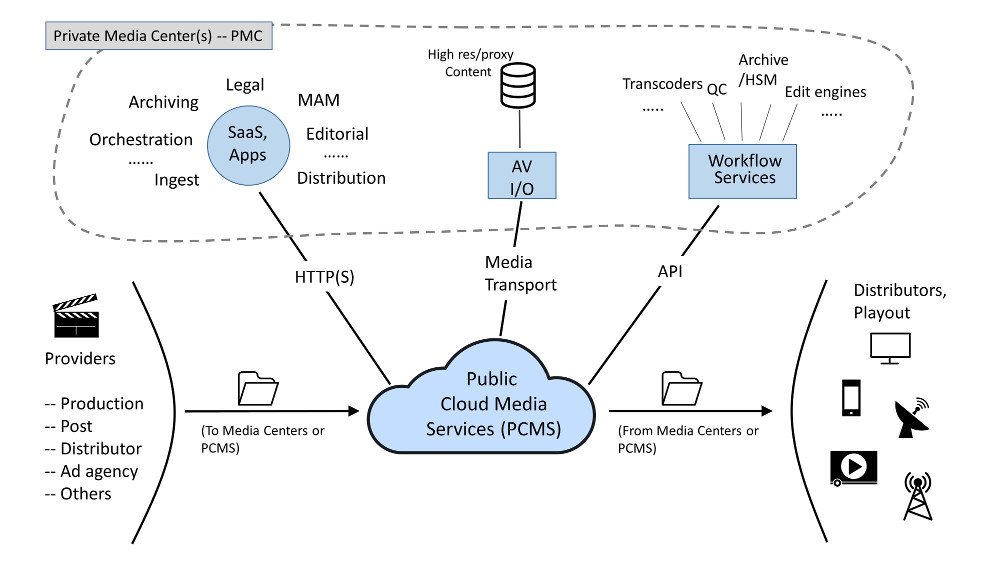Trending: Hybrid Cloud Media Systems
Click on the Image to Enlarge
The days are dwindling when a media production/broadcast company can ignore the public cloud for apps, processing and storage. The Cisco Global Cloud Index 2014–2019 predicts that 48 percent of all enterprise workloads will execute in the public cloud in 2019. How can system designers take advantage of this unstoppable trend? This article outlines the basics of the hybrid cloud media system.
First, what is a hybrid cloud? The National Institute of Standards and Technology (NIST) defines the hybrid cloud as follows:
The cloud infrastructure is a composition of two or more distinct cloud infrastructures (private, community or public) that remain unique entities, but are bound together by standardized or proprietary technology that enables data and application portability (e.g., cloud bursting for load balancing between clouds).
Hybrid clouds permit, say, a local media enterprise to divide up workloads with a public cloud. This way, existing, private, sunk cost, infrastructures can interface with public cloud services as needed. An example is use of the public cloud to archive video files while other media workflow aspects are done privately. Over time, more and more workloads (e.g. apps, transcoding, MAM, ingest, QC) may be moved to the cloud as desired until, in some cases, the local system is minimized. This way a holistic media infrastructure can be built with workloads divvied up across the system in a seamless manner that meets security and performance needs.
LOCAL AND SECURE
This is the beauty of the hybrid approach. Don’t want to store your crown jewels in the public cloud? No problem. Keep them safe and sound locally. Hybrid workflows can be designed to function with just about any local/cloud partitioning of media, processing, storage and control.
The professional video industry's #1 source for news, trends and product and tech information. Sign up below.
Here are some of the benefits of the hybrid cloud approach:
• Start small, scale to cloud according to workflow needs;
• Fewer desktop-installed apps; run Software-as-a-Service (SaaS) apps;
• Faster time to market for new products (business agility);
• Geo-diverse networked operations;
• Support for legacy product integration;
• Support for small, medium and large systems;
• Leverage virtualized cloud services; storage, processing, security, reliability, pay-as-you-go accounting (OpEx not CapEx accounting), and
• Rich APIs for customization as needed.
Even a few of these benefits can be sufficient reason to include the cloud in your workflow. However, for some, using any public cloud services is a “no go” because of security. Is this wise thinking?
There are many aspects to cloud security and multitenancy is near the top of the list. This is where a given user shares cloud resources (compute, storage, networking) with other mostly unknown users.
However, “There’s been no correlation between security failure and the degree of multitenancy,” said Jay Heiser, vice president of research for Gartner, at the Gartner Security & Risk Management Summit in June 2016. Gartner predicts that by 2018, increased security will displace cost savings and agility as the primary driver to move to public cloud. In the near future trusted public clouds will become the most secure place to store valuable digital assets. The tide is turning.
EXAMPLE HYBRID CLOUD MEDIA SYSTEM
Fig. 1: The diagram shows a generic hybrid cloud media system. The upper portion illustrates the local/private media center (PMC). The cloud portion (PCMS) contains services for storage, processing and app execution. (Figure concept: Prime Focus Technologies, CLEAR Software Suite. Download the white paper at tinyurl.com/PFT-CLEAR.)

Fig. 1 shows a generic hybrid cloud media system. The upper portion illustrates the local/private media center (PMC). The cloud portion (PCMS) contains services for storage, processing and app execution. There may be several PMCs that “share” the same cloud services and common cloud database for files and metadata. This encourages geo-diverse workflows. Also, the PCMS may, in fact, be a “multicloud” composed of several different public clouds, each offering a specific service that the others do not.
The PMC may be a broadcast operations center with apps, storage and workflow services/processes. Cloud-based software products are provided by traditional AV vendors and others with a cloud services product model (see for example aws.amazon.com/marketplace).
On the left of the figure are the providers of content, both live and file-based. On the right are a myriad of distributors and playout partners. Playout could be implemented at the PMC, of course.
Connectivity between the PMC and the cloud may be via the public internet or a private connection such as Metro Ethernet or a service such as Amazon Direct Connect (aws.amazon.com/directconnect).
Cloud connectivity choices and performance are only improving. Once connectivity is established, it is used to support three main types of communications between the PMC and the PCMS; one for apps, one for file/stream transport and one for services control. Of course there are other communication types such as monitoring, system configuration and provisioning, but these are outside of the scope of this article.
A summary of the three media-related types follows:
• SaaS apps executing in the cloud with a web browser user interface (e.g. aviary.com). The days of desktop-installed apps are fading. Sure there are good reasons for performance heavy apps such as real-time AV editing to be installed, but most media workflow apps can be SaaS-based.
• AV file/stream I/O: In the hybrid model, there will be file and stream transport between the PMC and the PCMS. Some sort of “edge appliance” may assist in security and data acceleration.
• Workflow services: This is key to the success of the hybrid model. Legacy PMC products may be controlled from a cloud controller. For example, PMC files can be checked locally for quality and standards compliance (QC), but control is from cloud orchestration. So legacy PMC systems can be integrated into a hybrid system without rip-and-replace tactic. As legacy is phased out, migrating to a cloud-based equivalent is an option.
Reduced hybrid versions are possible with, say, only some SaaS or only some cloud storage implemented. There are many variations of the hybrid model. This article just scratched the surface of this important area.
To learn more, visit:
• azure.microsoft.com/en-us/services/media-services
• www.primefocustechnologies.comwww.deluxemediacloud.comwww.sonymcs.com
• www.tedial.com, and others.
There are many broadcasters taking advantage of the hybrid model today, so become familiar with its benefits and tradeoffs.
Al Kovalick is the founder of Media Systems consulting in Silicon Valley. He is the author of “Video Systems in an IT Environment (2nd ed).” He is a frequent speaker at industry events and a SMPTE Fellow. For a complete bio and contact information, visitwww.theAVITbook.com.

